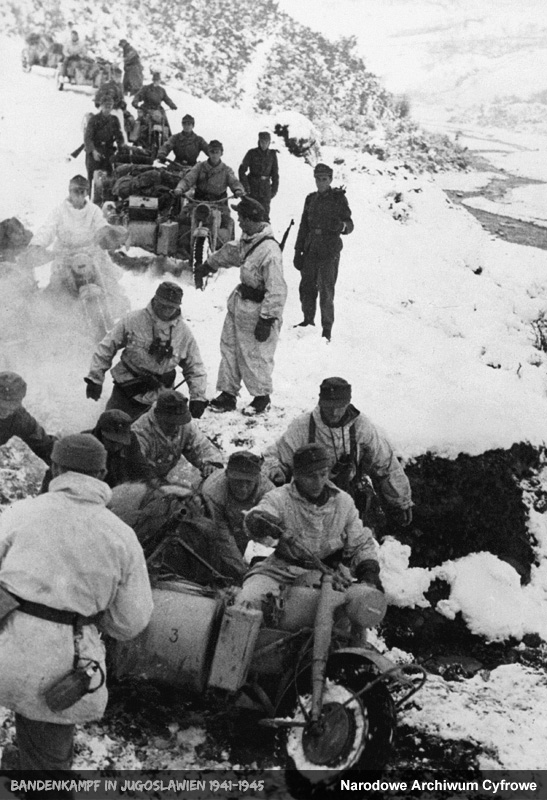Members of the SS Division "Prinz Eugen" transmitting a message through photophone (Lichtsprechgerät 80), a device that uses light beams to transmit speech over long distances. This kind of technology was extremely helpful to the German troops in the hills of Yugoslavia, because it allowed easy and fast transmission of messages, without the possibility of interception by the enemy.
Text: Ivan Ž.
Photographer: Eugen Nonnenmacher, SS War Correspondent Battalion.
Date: 1943.
Location: unknown, Yugoslavia.
Original caption: "The speaking light. The most modern technology is found in the German Armed Forces, deployed and used. Like a speaking light device. A grenadier reads the message, just brought in by a messenger, into the microphone, and the light-speaking device converts the words into rays that are reconverted into sound by the remote receiving device. In this way, the distances are easily bridged and the speed of action in battle-decisive moments is determined by this ingenious and most modern equipment, which cannot be intercepted by the enemy."
Sources: Michael Sharpe, Brian L. Davis, Das Reich – Waffen-SS Armoured Elite, Ian Allan Publishing, Hersham, Surrey, 2003, p. 73; The National Archives, ADM 220/1634; Eugen Nonnenmacher, "Das sprechende Licht", Deutsche Zeitung in den Niederlanden, Amsterdam, 09.09.1943, vol. IV, no 96, p. 1.
NOT ALLOWED: removing source credits from the files; using text without crediting the original author; using files and information for political propaganda and commercial purposes.
Pripadnici SS-divizije "Princ Ojgen" prenose poruku putem fotofona (Lichtsprechgerät 80), uređaja koji svetlosnim zracima prenosi govor preko velikih udaljenosti. Ovakva tehnologija bila je od velike pomoći nemačkoj vojsci u brdima Jugoslavije, jer je omogućavala lak i brz prenos poruka, bez mogućnosti presretanja od strane neprijatelja.
Tekst: Ivan Ž.
Fotograf: Ojgen Nonenmaher, Ratnodopisnički bataljon SS-a.
Datum: 1943.
Mesto: nepoznato, Jugoslavija.
Originalni natpis: "Svetlo koje govori. Najsavremenija tehnologija nalazi se u nemačkim oružanim snagama, u upotrebi i primeni. Kao što je svetlosni uređaj koji govori. Grenadir čita poruku, koju je upravo doneo kurir, u mikrofon, a svetlosnogovorni uređaj pretvara reči u zrake koje vraća u zvuk udaljeni prijemnik. Na ovaj način daljine su lako premostive, a brzinu dejstva u odlučujućim trenucima borbe određuje ova genijalna i najsavremenija oprema, koju neprijatelj ne može presretati."
Izvori: Michael Sharpe, Brian L. Davis, Das Reich – Waffen-SS Armoured Elite, Ian Allan Publishing, Hersham, Surrey, 2003, str. 73; The National Archives, ADM 220/1634; Eugen Nonnenmacher, "Das sprechende Licht", Deutsche Zeitung in den Niederlanden, Amsterdam, 09.09.1943, god. IV, br. 96, str. 1.
NIJE DOZVOLJENO: uklanjanje naziva izvora sa fajlova; korišćenje teksta bez navođenja izvornog autora; korišćenje fajlova i informacija u političko-propagandne i komercijalne svrhe.











